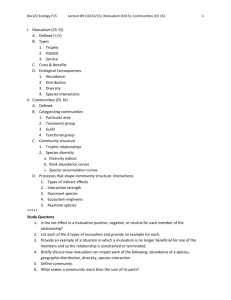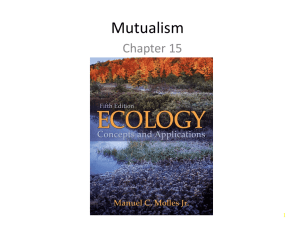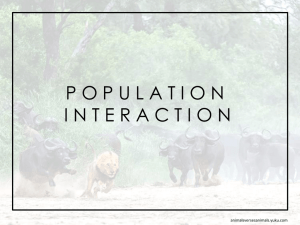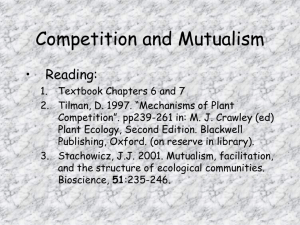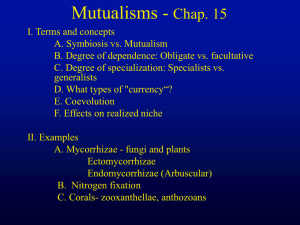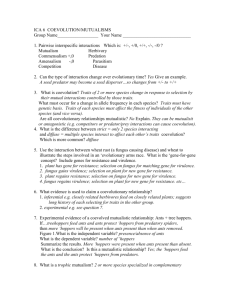Week 12 2010
advertisement
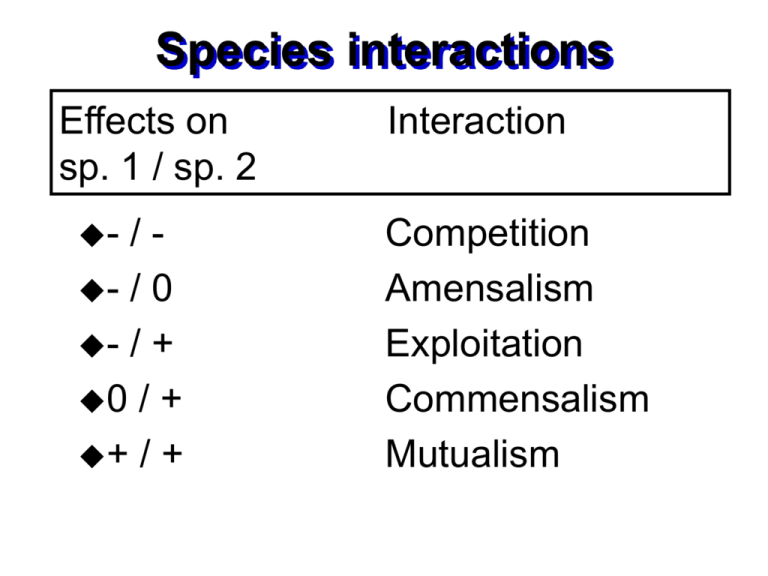
Species interactions
Effects on
sp. 1 / sp. 2
-
/- / 0
- / +
0 / +
+ / +
Interaction
Competition
Amensalism
Exploitation
Commensalism
Mutualism
Mutualism
• Mutualism is not synonymous with
symbiosis
• Mutualism: mutually beneficial interaction
• Symbiosis: living in intimate association
• symbioses may be:
– exploitative (e.g., Schistosomiasis, Heart
worm)
– mutualistic (e.g., bacteria in gut, zooxanthellae)
– neutral (e.g., many bacteria on skin)
Mutualism vs. other interactions
• Not as well-studied as predation &
competition
• Not modeled as frequently
• Not studied experimentally as frequently
Facultative vs. Obligate
• Obligate: Interaction is required for life of
one or both members
• Facultative: Interaction, though beneficial,
is not absolutely required
• For a pair of mutualists, the relationship
may be facultative for one and obligate for
the other
Examples of mutualisms
• Flowering Plants &
Pollinators
• Bees, butterflies,
flies, beetles,
wasps, birds, bats,
others
• some obligate,
some facultative
• variable specificity
Examples of mutualisms
• Cleaner mutualism
• Fish, shrimp, some
birds
• Small organism
removes
ectoparasites from
larger organisms
• facultative,
nonspecific
Examples of mutualisms
•
•
•
•
•
•
Ants & Aphids
Aphids feed on phloem
High sugar, low Nitrogen
Excess sugar excreted
Ants feed on sugar excretions
Ants defend aphids against
predators
• facultative for both
Examples of mutualisms
• Mycorrhizal mutualism
• Roots of most plants colonized by fungi
• fungi provide H2O and nutrients,
especially Phosphorus
• plant provides carbohydrates
Ectomycorrhizal mutualisms
• fungal mycelium covers root surface and
penetrates between cells
• most trees, forest mushrooms
• for the fungus - facultative
• for the plants - sometimes obligate
Endomycorrhizal (AM) mutualisms
• Arbuscular Mycorrhizal
fungi
• most non-woody plants
• fungi penetrate plant cells
• arbuscules: site of
exchange
• for the fungus - obligate
• for the plant - facultative
Mutual altruism or
mutual exploitation?
• Mutualism has costs and benefits to
both parties
• Costs and benefits depend on the
environment
– cost > benefit … parasitism
– cost < benefit … mutualism
• Example: AM fungi and plants
AM fungi and plant root
– 7 to 20% of daily total
ROOT
• Benefit: Plant gets P
• Roots deplete P in soil
• Fungal hyphae extend
plant’s ability to get P
• Cost: Plant must give
photosynthates to
fungus
root hairs
Zone of depletion
(root hair)
Zone of depletion
(fungal hyphae)
fungal hyphae
Soil conditions alter relationship
• Low P soil
• Plants without
mycorrhizal fungi
cannot get enough P
• Mycorrhizal plants
grow more rapidly than
non-mycorrhizal plants
• Benefit > Cost
• Mutualism
• High P soil
• Plants obtain ample P
even without
mycorrhizal fungi
• Mycorrhizal plants
grow less rapidly than
non-mycorrhizal plants
• Benefit < Cost
• Parasitism
References: West 1997; Peng et al. 1993; Fitter 1985, 1991; Koide & Elliott 1989
Other potential effects on this
relationship
• High light
• High photosynthesis
• High carbohydrate
availability
• Plant can easily afford
to pay the cost of
having AM fungi
• Mutualism
• Low light (shade)
• Low photosynthesis
• Low carbohydrate
availability
• Plant less able to pay
the cost of having AM
fungi
• Parasitism
General point
• Mutualism depends on the balance of
costs and benefits
• For plants, that balance may vary in
space and in time
• Mutualism Parasitism
• For fungus, plant always provides net
benefits (benefit > cost)
Direct vs. Indirect mutualism
• Direct mutualism: Benefits occur
between individuals, and without
intermediaries
– an individual phenomenon
– may have population or community effects
• Indirect mutualism: Benefits depend on
effects on a 3rd species
– often propagated through trophic network
– a population phenomenon, usually with
community effects
Dynamic effects of mutualism
• How does mutualism affect population
growth ( dN / dt )?
– Increase equilibrium density
– Increase maximum population growth
– Increase both equilibrium density and
maximum population growth
– Increase neither equilibrium density and
maximum population growth
Lotka-Volterra models of mutualism
• Mutualism modeled as negative competition
• Competition
dN1 / dt = r1 N1 [ K1 - N1 - a2 N2] / K1
– a2 is the per capita effect of N2 reducing effective
dN1 / dt
• Mutualism
dN1 / dt = r1 N1 [ K1 - N1 + b2 N2] / K1
– b2 is the per capita effect of N2 increasing
effective dN1 / dt
Lotka-Volterra mutualism
isoclines
N2
2-species
equilibrium
K2
dN1/dt = dN2/dt = 0
K1
N1
Lotka-Volterra models of mutualism
• Isoclines have positive slopes
• Equilibrium exists and is stable if b1b2 <
1.0
– Both species attain greater equilibrium
densities when together vs. when alone.
• Equilibrium is undefined if b1b2 > 1.0
– Isoclines don’t cross
– Both species increase to
Lotka-Volterra models of mutualism
• Suppose mutualism coefficients are not
constants
• Suppose b’s decrease as N1 and N2
increase
• At sufficiently high N ‘s, mutualist has
no effect on dN / dt
• Stabilty
• Increase equilibrium density
Modified Lotka-Volterra
mutualism isoclines
N2
2-species
equilibrium
K2
dN1/dt = dN2/dt = 0
K1
N1
Increased maximum dN / dt
• Suppose r1 is an increasing function of N2
dN1 / dt = r1 N1 [ K1 - N1 ] / K1
– where: r1 = rmax N2 / [ k1/2 + N 2 ]
– as N2 increases, r1 rmax
r1
rmax
k1/2
N2
Example: Pollinators
• Suppose K for the plant is set by available
space (or by soil nutrients or by light)
• Pollinators may increase seed set and
therefore increase maximum dN / dt
• Pollinators don’t alter available space so
don’t alter K
Inreased equilibrium density
and maximum dN / dt
• Suppose r1 is an increasing function of N2
dN1 / dt = f (N2) N1 [ K1 - N1 + b2 N2] / K1
– where: f (N2) is an increasing function of N2
• Example: Ants & Aphids
– ants increase survivorship & reproduction of
aphids (increase dN / dt )
– ants alter equilibrium density (by local
elimination of enemies)
No effect on equilibrium density
and maximum dN / dt
• Benefits of mutualism may be to
individuals
• Those that have mutualists have
advantage in intraspecific competition
• But, no necessary advantage at population
level.
Resource based mutualisms
• Lotka-Volterra models phenomenological
• Resource based models mechanistic
• Resource processing
– Resources may pass through a series of transformations
caused by their use by organisms
RESOURCE
MODIFIED
RESOURCE
Resource processing
• When resource is changed by processing, it
may become valuable to another species
• Different consumers may specialize on the
same resource in different states
• Processing chain
• Models:
– Heard, S. B. 1994. J. Anim. Ecol. 63:451-466
– Heard, S. B. 1995. Ecol. Modelling 80:57-68
• Experiments
– Daugherty & Juliano 2002. Ecological
Entomology
Processing chain examples
• Vinegar
– yeast consume sugar, excrete alcohol
– Acetobacter consume alcohol, excrete acetic acid
• Stream invertebrates
– leaves, eaten by shredders (e.g., pteronarcid
stoneflies, tipulid flies)
– defecate fine particles, fed upon by filterers,
gatherers (e.g., simuliids - blackflies, mayflies,
chironomids)
Processing chain examples
• Predation & scavenging
– large predators (e.g., lions)
– carrion eaters (e.g., vultures)
• Fish carrion
– Bald eagle
– Crows, gulls
• Many other examples (see Heard 1994,
Journal of Animal Ecology 63:451-464)
supply p
loss
w1(R1)
Resource
condition 1
(upstream) R1
consumer
independent
processing h (R1)
loss
w2(R2)
A two species
processing
chain
consumption
f1 (R1,S1)
consumer
dependent
processing
s [f1 (R1,S1)]
Resource
condition 2
(downstream) R2
consumption
f2 (R2,S2)
Consumer 1
(upstream)
Consumer 2
(downstream)
Processing has multiple effects
• Upstream consumer exploits the resource
– reduces its value (e.g., energy content)
• Downstream consumer cannot use the
resource until it is processed
– by upstream consumer
– by other means
• Upstream consumer, by processing, makes
resources available to downstream consumer
A simple processing chain model
•
•
•
•
•
•
•
•
R1 … upstream resource
R2 … downstream resource
S1 … upstream consumer
S2 … downstream consumer
p … supply rate of upstream resource
h(R1) … consumer independent processing
w1(R1) … loss rate for upstream resource
w2(R2) … loss rate for upstream resource
A simple model of a
processing chain
• f1 (R1 , S1) … resource consumed by upstream
consumer
• f2 (R2 , S2) … resource consumed by
downstream consumer
– note: feeding functions could be in the form of
saturation kinetics models.
• s … fraction of upstream resource that is used
by the upstream consumer and made available
to the downstream consumer
A simple model of a
processing chain
• m1 … upstream consumer per capita mortality
• m2 … downstream consumer per capita
mortality
• g1 … growth per unit resource consumed for
upstream consumer
• g2 … growth per unit resource consumed for
downstream consumer
A simple model of a
processing chain
•
•
•
•
•
dR1 / dt = p - h(R1) - w1(R1) - f1(R1,S1)
dR2 / dt = h(R1) - w2(R2) + s [f1(R1,S1)] - f2(R2,S2)
dS1 / dt = g1{(1 - s)[f1(R1,S1)]} - m1(S1)
dS2 / dt = g2{[f2(R2,S2)]} - m2(S2)
equilibrium
– growth rates = 0
– S1* , S2* , R1* , R2*
Commensal vs. Amensal
• Effects are one way
– S1 can affect S2, but S2 cannot affect S1
• Consider equilibrium S2 when:
– S1 > 0 … upstream consumer present
– S1 = 0 … upstream consumer absent
• S2* | S1 > 0 > S2* | S1 = 0 … commensal
• S2* | S1 > 0 < S2* | S1 = 0 … amensal
What determines commensal vs. Amensal
• Equilibrium commensalism occurs when
s > h / (h + w1)
•
•
•
•
sloppiness (s) is large
loss of upstream resource (w1) is large
consumer independent processing (h) is small
However, all equilibrium amensal relationships can
behave as commensal relationships prior to
equilibrium
– short term increases in S2 due to S1
Resource based mutualisms
• Holland & DeAngelis 2010. Ecology 91:1286–1295
• Multiple resource-consumer mutualisms
– facultative, obligate, one-way, two-way
•
e.g., mycorrhizae
– plant provides fungus with carbohydrate
– Fungus provides plant with P
Resource based mutualisms
dM1/dt =
M1[r1 + c1(Fmax12M2/(K2+M2)) – q1(Smax1M2/(e1+M1)) – d1M1]
dM2/dt =
M2[r2 + c2(Fmax21M1/(K1+M1)) – q2(Smax2M1/(e2+M2)) – d2M2]
Mi = number or biomass
Fmax, K = Feeding paramters
Smax, e = supply paramters
di = death rate
ci , qi = conversion efficencies
Key results
• Mutualisms can yield multiple equilibrium
abundances
– Some stable, some not.
• Depends on
– unidirectional/bidirectional
– obligate/facultative
• Overexploitation and extinction of a mutualist are
possible
• Transient dynamics may be inconsistent with the
mutualism effect on equilibrium abundance
Consumer-Resource mutualisms
• Takes a cost – benefit approach
• But puts a mechanism on costs and
benefits (consumption)
• Places costs and benefits into a common
currency
Indirect mutualism
• Beneficial interactions
depend on a 3rd
species or a network
– predation on
predators, competitors
– competitor of
predators, competitors
– positive effects
necessarily at the
population level
competitor #1
food
competitor #2
space
competitor #3
Indirect mutualism
(Fritz 1983)
• Insects on Black Locust
• Herbivores
– Vanduzea -- membracid treehopper, honeydew
– Odontota -- chrysomelid beetle, leaf miner
– other herbivores
• Ant
– Formica -- tends Vanduzea, feeds on honeydew,
attacks other herbivores and predators
• Predator
– Nabicula -- nabid bug, preys on Odontota
Chris Evans
, The University of Georgia
Ant mutualist effects on plant?
•
•
•
•
Branches with ants have fewer other herbivores
Branches with ants have 51% fewer Odontota adults
Ants benefit plant?
Exclude ants from small trees & compare to control
– With ants: fewer Odontota, Nabicula
– With ants: Odontota larvae survive at greater rate
– With ants: Greater defoliation
• Net effect of ants on plant is detrimental
– depends on strengths of direct & indirect effects
Black Locust system
Nabicula
Formica
Vanduzea
Odontota
Black Locust
Other herbivores
Community level effects
of mutualism
• How might direct mutualisms affect
community properties?
– species number & relative abundance
• Can mutualists reduce the impact of
competition? Or predation/herbivory?
– keystone mutualists
• read: Morris et al. 2007 Ecology
Microcosm experiment
(Grime et al. 1987)
• Festuca ovina - canopy dominant
• 20 other species
• Treatments
– Grazing (scissors)
– Soil heterogeneity
– AM fungi
Microcosm experiment
(Grime et al. 1987)
• Grazing
– appeared to increase number of species
slightly
– appeared to increase diversity index
• AM
– appeared to increase number of species
slightly
– appeared to increase diversity index
• NOTE - no real data analysis here
Microcosm experiment
(Grime et al. 1987)
• AM
– significantly lowered abundance of F. ovina
– significantly raised abundances of low-stature,
sub-dominant species
Microcosm experiment
(Grime et al. 1987)
• Radio C tracer study
– 14CO2 provided to F. ovina
– 72 h later 14C appears in neighboring plants
• in VAM replicates 14C is 3 - 150 X greater than in
non-VAM replicates
• in VAM replicates 14C is 10 - 100 X lower in a nonmycorrhizal species ( Rumex acetosa )
– suggests C transfer from dominant to subdominant species via mycorrhizae
Community effects
of AM fungi
• Fungal mycelium often connects multiple
species
• Do fungi equalize competitors by serving
as a conduit for C among plants?
• Other investigations also show 14C
transferred between plants
However…
• Bergelson & Crawley note:
– This and other radiotracer studies show that
14C moves between plants, but NOT that
there is net movement
– Festuca ovina clearly harmed by AM
– Releases sub-dominant species from
competition
– Increases evenness
– Little effect on species number
Alternative hypotheses
• AM increase diversity by redistributing C
away from dominant and to sub-dominant
spp.
• AM increase diversity by parasitizing
dominants (C), and secondarily by
benefiting sub-dominants (P)
Net movement of C
• Waters & Borowicz 1994 Oikos 71:246-252
• Is there net flow of C through AM toward a
stressed plant?
– Stress = C drain
– Herbivory, shade
Design & Results
Clipping
& 14CO2
(Waters & Borowicz 1994)
14CO
2
14CO
2
Clipping
14CO
14CO
2
2
14CO
2
Results
• Net flow of 14C away from the stressed
plant
– away 100x > toward
• In the absence of fungi, this effect is
absent
• Stressed plants do not seem likely to
benefit from AM fungi … perhaps the
opposite
Do mycorrhizal fungi have
community level effects?
• Experiments show that they may
• Not necessarily mutualists
• Direct effects may involve qualitatively
different interactions with different plants
– benefit some (mutualists)
– harm others (parasites)
• May enhance diversity or reduce it
• Context dependence
